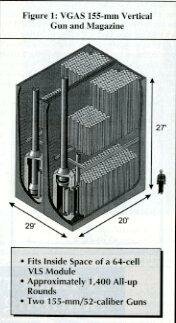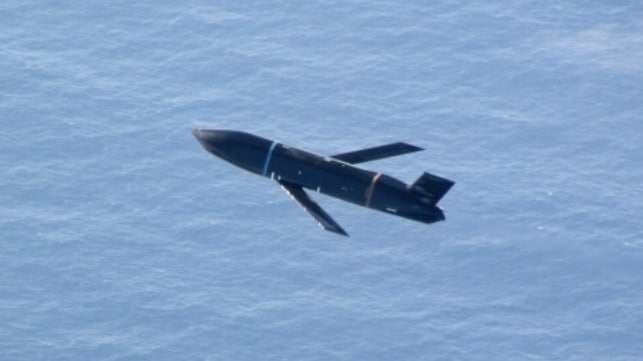apparition13
I really should change my personal text
- Joined
- 27 January 2017
- Messages
- 605
- Reaction score
- 1,106
I find myself quite frustrated that AGS replaced VGAS. VGAS with an 5"/127mm gun makes more sense to me than AGS does. You would still have direct fire, but the VGAS module itself is a much more flexible piece of kit that can go in any ship with the space for a 64 cell Mk41 module, so you don't need to develop a special ship to carry a special gun, you can deploy it on existing ships like the Spruance family, and even on Burkes. I've also had difficulty finding information on the system, so if anyone has additional details or information please post them to here.
It also looks as if it is two separate modules in one 64 cell vls space, so you could perhaps do a 32 cell vls and a single vgas gun side by side in one 64 cell modules space. That would be useful as well. It could work as a Spruance refit, with the 32 vls cells used like in the Japanese DDs with 16 VL-ASROC and 64 ESSM on one side and 700 LRLAP, or better yet a multi-purpose round that can attack ships as well, on the other. You could do the same with the rear module on a Burke to make an ASW specialized or general purpose variant, depending on the loadout for the forward 32 cell module. VGAS really is such a missed opportunity.
By the way, does anyone know what kind of muzzle velocities were anticipated, and what the fire rate was supposed to be? I wonder if it might be practical to develop AAW rounds as well if the velocities are high enough. You could use it as a first stage for a slightly narrower and shorter Barak-1, or an ADATS with a different seeker, if you want terminal maneuvering. CAAM is about a meter too long and like Barak-1 a little too wide, but perhaps a 2/3rds length and narrower CAAM could also work. A 32 cell space carrying 700 AAW rounds would certainly increase magazine depth, even if fire rate dropped to 12 per minute from one per second, assuming the initial AGS rate is the same as the VGAS rate, even though I'd think VGAS would fire faster given how much easier it would be to load or even cool the barrel should that be necessary. Go with two modules and you could be at one per 2 seconds.
You could have SM-3 and SM-6 for theater range, VGAS for area defense replacing SM-2 and ESSM, and RAM or 76mm David/Strales for terminal when you need a really high rate of fire.
So many possibilities foregone. Pitch it as a retrofittable system and Congress might bite. If the Zumwalt with VGAS program gets too expensive the Spruances with VGAS could be kept around a while, while VGAS Burkes are built until a CGBL or super-Burke along the lines of Sejong the Great or Atago could be built as a fall back to DDX and CGX.
Anyone else find this illustration confusing? It looks like it is mislabeled. The side that says 20' looks like the 29' side and the side that says 29' looks like the 20' side. A single gun module size of 10'x29' (roughly 3mx9m) looks like it makes more sense than the alternate arrangement, so I wonder whether it is mislabeled or the illustrator got it wrong.
It also looks as if it is two separate modules in one 64 cell vls space, so you could perhaps do a 32 cell vls and a single vgas gun side by side in one 64 cell modules space. That would be useful as well. It could work as a Spruance refit, with the 32 vls cells used like in the Japanese DDs with 16 VL-ASROC and 64 ESSM on one side and 700 LRLAP, or better yet a multi-purpose round that can attack ships as well, on the other. You could do the same with the rear module on a Burke to make an ASW specialized or general purpose variant, depending on the loadout for the forward 32 cell module. VGAS really is such a missed opportunity.
By the way, does anyone know what kind of muzzle velocities were anticipated, and what the fire rate was supposed to be? I wonder if it might be practical to develop AAW rounds as well if the velocities are high enough. You could use it as a first stage for a slightly narrower and shorter Barak-1, or an ADATS with a different seeker, if you want terminal maneuvering. CAAM is about a meter too long and like Barak-1 a little too wide, but perhaps a 2/3rds length and narrower CAAM could also work. A 32 cell space carrying 700 AAW rounds would certainly increase magazine depth, even if fire rate dropped to 12 per minute from one per second, assuming the initial AGS rate is the same as the VGAS rate, even though I'd think VGAS would fire faster given how much easier it would be to load or even cool the barrel should that be necessary. Go with two modules and you could be at one per 2 seconds.
You could have SM-3 and SM-6 for theater range, VGAS for area defense replacing SM-2 and ESSM, and RAM or 76mm David/Strales for terminal when you need a really high rate of fire.
So many possibilities foregone. Pitch it as a retrofittable system and Congress might bite. If the Zumwalt with VGAS program gets too expensive the Spruances with VGAS could be kept around a while, while VGAS Burkes are built until a CGBL or super-Burke along the lines of Sejong the Great or Atago could be built as a fall back to DDX and CGX.


